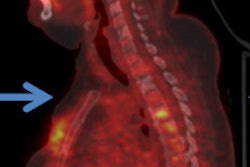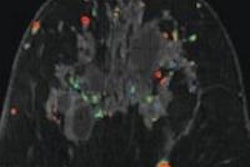
Radiologists miss breast cancer on mammography exams for many reasons, including failures of perception, poor compression or positioning, and breast density. But another reason is that the human brain may be wired to miss targets when they occur less frequently, according to a study published in PLOS One.
Researchers at Brigham and Women's Hospital tested the rates of missed cancer for radiologists based on the prevalence of cancer cases. They found that radiologists missed almost twice as many breast cancers when the cases were inserted slowly into regular clinical workflow than when they read the same cases separately in one sitting (PLOS One, May 30, 2013).
"Whenever there's a task that requires vigilance, if the target is rare, people miss it," lead author Karla Evans, PhD, told AuntMinnie.com. "This is adaptive when you're talking about UFOs, but it's not as adaptive in tasks like medical screening."
 Karla Evans, PhD, from Brigham and Women's Hospital.
Karla Evans, PhD, from Brigham and Women's Hospital.
For the study, Evans and colleagues Dr. Robyn Birdwell and Jeremy Wolfe, PhD, selected 100 cases: 50 with biopsy-confirmed cancers and 50 that were negative. In the first study arm, they anonymized the cases and added them into the regular screening workflow of 14 radiologists at Brigham and Women's Hospital over a nine-month period. The radiologists in this setting read mammograms in batches a few hours or days after their acquisition. Evans and colleagues called this arm the "low-prevalence" cohort due to the lower prevalence of disease relative to all of the mammograms being viewed.
In the study's second arm, the same 100 cases were interpreted in a single sitting by six members of the same group of participating radiologists. This group was called the high-prevalence cohort, as 50% of the cases included the presence of cancer.
When the 100 experimental cases were read in one sitting, the rate of missed cancer was 12%. In comparison, the rate of missed cancer was 30% in the low-prevalence arm, Evans' group found.
Of 15 cancers missed in the low-prevalence cohort, seven (47%) were found by all six radiologists in the high-prevalence arm of the study; the remaining eight were detected by at least one radiologist in the high-prevalence part of the study.
"It's not that radiologists can't detect the cancers," Evans said. "But when they're in a situation where cancers are rare, their brains use conservative criteria. They'll see something and ask themselves, 'Is this really cancer?' and decide most likely it's not -- and not report it."
Training the brain
This tendency is an ingrained visual mechanism, rather than negligence or incompetence, Evans said; it's a case of "if you don't find it often, you often don't find it."
In fact, a recent study conducted by researchers from the University of Sydney in Australia found that perceptual errors linked to poor performance in mammographic interpretation were influenced by the number of readings radiologists performed annually. Those who read fewer than 1,000 mammography studies per year showed worse diagnostic accuracy than those who read more than 1,000.
But there are ways to train the brain's visual search process, Evans said.
"One way to ameliorate this tendency to miss rare targets would be to have radiologists come in before they start screening and go through a series of high-prevalence exams," she told AuntMinnie.com. "We think it would shift their criteria, they'd be less conservative in their interpretations, and it would reduce the miss rate we're seeing."
Another idea is to seed cancer studies into a practice's regular workflow, as Evans and colleagues did in the study, although this approach presents technical and ethical challenges.
"Seeding cancer studies into regular workflow, especially in small clinics where radiologists don't interpret the volume of mammograms that colleagues at big clinics do, could raise the number of cancers caught," she said. "Of course, you'd have to be sure not to violate HIPAA constraints, and there are technical issues of how to insert the cancer cases so they don't look like test cases."
Other methods to improve performance include continuing education efforts, prospective double reading, or retrospective evaluation of missed cases, according to the authors.
"This phenomenon is not a failing of radiologists, it's how the brain works," Evans said. "But it does affect clinical practice, and it needs to be studied further."




















